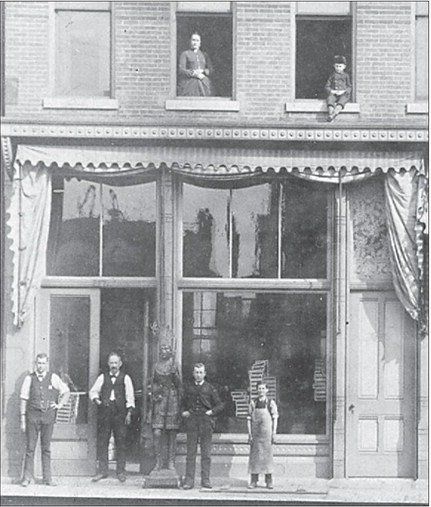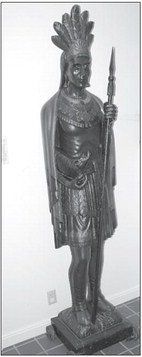Harry's gift: An American legacy

Before the arrival of
today’s discount smoke shops, Quincy had a thriving trade in the production and
sale of tobacco products. Wooden cigar store Indians advertised Quincy’s
tobacco business and became icons of local commerce.
”Big Chief Badger” guarded the entry to the tobacco shop of
Harry Klene, a prominent Quincy businessman and veteran cigar maker.
Klene’s
father, Ferdinand, had come to Quincy from Hanover, Germany, in 1852. Two years
later he joined the rush to California, where he pursued mining and cigar
manufacturing. In 1869 Ferdinand left the West Coast to return to Quincy,
traveling by way of the Isthmus of Panama and proceeding by ship to New York
City, where he purchased the wooden Indian.
Ferdinand brought Chief Badger to
Quincy and established a tobacco store at 127 South Fourth Street. The Chief
and the business remained at that address until Harry’s death in 1958.

Harry Klene’s will provided a bequest of the cigar store Indian to the Historical Society, and an accompanying letter revealed additional details about its origin.
The Indian was purchased second- hand from a New York cigar maker named Cohen for $145. Klene believed the Indian was carved from birch wood by one of the artisans who created the magnificent figureheads gracing the old-time sailing vessels. According to Klene’s letter, the carver procured the wood from the lower end of the main mast of an old sailing ship that had been retired from service. This wood was used because wood from inside the hold would be thoroughly dry and well-seasoned and would not split or crack. The letter asserts that the carver used a member of the Iroquois Tribe to pose for his work. Members of this eastern tribe are said to have facial features more like the longer faces of the white or Caucasian race than the more rounded features of western tribes.
An examination of New York City directories suggests that the original owner was Moses S. Cohen, an immigrant from Holland whose manufactory was at the lower end of Manhattan from 1848 until his death in December 1864. The location was close to the city’s booming ship building industry. Ship building had become important in New York in the 1820s with the completion of the Erie Canal. By 1848 New York was the world’s largest ship producer and had started producing fast clipper ships for the California gold trade.
One of the trade groups whose members helped construct the big wooden clippers was the Ship Carvers Guild. Its artisans created the detailed ornamentation that adorned the ship from front to back. At the front of ship was the large sculpted figurehead for which the carvers are best known. In the 1840s and 1850s these artisans supplemented their business by carving figures for advertising, such as cigar store Indians for tobacco shop owners. In New York during this time, ship carving was done principally by just six craftsmen: Jeremiah Dodge, Charles Dodge, Jacob Anderson, John Cromwell, Thomas Millard, and Thomas Brooks. The Klene letter does not say which artisan created Chief Badger with his long-faced smooth style.
Jeremiah Dodge, the senior carver, his son Charles and Jacob Anderson formed a partnership in which they developed a style of carving known for its realistic detail that gave their wood subjects the appearance of Greek or Roman marble sculptures. Their carvings appeared extremely sensitive to fine detail important to expressing the character of their subject. This approach was popular in the United States in the early 19th century. It was called the neoclassical movement. Neoclassical artists sought to compare their new country with the democratic ideals of early Western Civilization. Their view of the Indian was that of a Noble Savage, a stoic moral individual who lived life off the land close to nature.
This is the ideal one sees in Klene’s Chief Badger. He is a calm, nonthreatening individual, holding a small beaver in his arm. He seems confident and unafraid, yet causes the viewer no alarm. He carries a large spear at his side, but his demeanor is one of a hunter, not a warrior. His eyes show no fear or rage. He is master of the natural world in which he lives.
Cromwell, Millard and Brooks, the other three carvers, developed a style that portrayed the Indian more as the warrior. Their subjects frequently had wide eyes of rage or a stance of impending attack with a raised arm ready to strike with a tomahawk or knife. Their Indian was an ignoble savage, bloodthirsty and treacherous. At best they saw him as a melancholic romantic hero on an inevitable course of destruction because of American manifest destiny. It was this style that was popular in cigar shops well into the 20th century.
Harry Klene’s gift to the Historical Society would be important even if it were an example of the latter style that populated most of the cigar shops in this country. Over a hundred thousand of these wooden Indians came to guard tobacco stores all over the United States, of which an estimated 2,000 exist today. Chief Badger’s importance is that it is from the early neoclassical style of carving. Only about two dozen survive.
In his gift, Klene sought to share with his neighbors something he knew was rare and special and that represented his life’s work and that of his immigrant father. In the letter that accompanied the gift of Chief Badger, one can feel Harry’s pride in the artistic sculpture. This pride, like the business, had been passed down to his son by the hard working Ferdinand.
In turn, the other immigrant cigar maker Moses Cohen, who first acquired Chief Badger in the early 1850s, had passed the legacy and pride along to Ferdinand. It was like the pride of Chief Badger’s creator, who procured from an old ship a piece of well-seasoned wood and created a faultless work of art. To this day the face of Chief Badger is as smooth as silk, and the sculpture has the appearance of a Greek god.
Dave Dulaney is a John Wood Community College employee and serves on the boards of the Historical Society, Gardner Museum, and Midwest Riverboat Buffs Historical Club. He is a speaker, author, and collector of memorabilia pertaining to local history and steamboats.
Sources
"Big Chief Badger in Historical Building." Quincy Herald-Whig, October 12, 1958.
"Ferdinand Klene Succumbs In Home." Quincy Whig, September 13, 1916.
Fried, Frederick. Artists in Wood: American Carvers of Cigar-Store Indians, Show Figures, and Circus Wagons. New York: Clarkson Potter, 1970.
Husar, Edward. "Life-size wooden Indian finds new home inside center." Quincy Herald-Whig, June 27, 1986.
"Klene Will Sets Up Never Ending Trust. Wooden Indian Given to Quincy Historical Society." Quincy Herald-Whig. Article found in Scrapbook Number 4, Historical Society of Quincy and Adams County (189).
New York City Directory, 1848. Doggett (94), Moses S. Cohen, Importer, 25 New, h 116 Leonard.
New York City Directory, 1858-59. Moses S. Cohen, Segar, 124 Water, h. Hoboken (159).
New York City Directory, 1862. Throw's (165), Moses S. Cohen, Segar, 124 Water, h. 252 W. 42nd.
New York City Directory, 1864-65. Moses S. Cohen, Tobacco, 124 Water, h. 252 W. 42nd (171).
N.Y. State Mercantile Union Business Directory, 1850. Moses S. Cohen, Segar, 25 New (117).
"Old Cigar Man Dies." Quincy Herald, September 13, 1916.
Schuman, Evan. "From the Sidewalk to Sotheby's, The Cigar Store Indian is a piece of American tobacco history."
(Winter, 2004-2005): 78-88.
Sessions, Ralph. The Shipcarvers' Art: Figureheads and Cigar-Store Indians in Nineteenth-Century America. Princeton: Princeton University Press, 2005.






